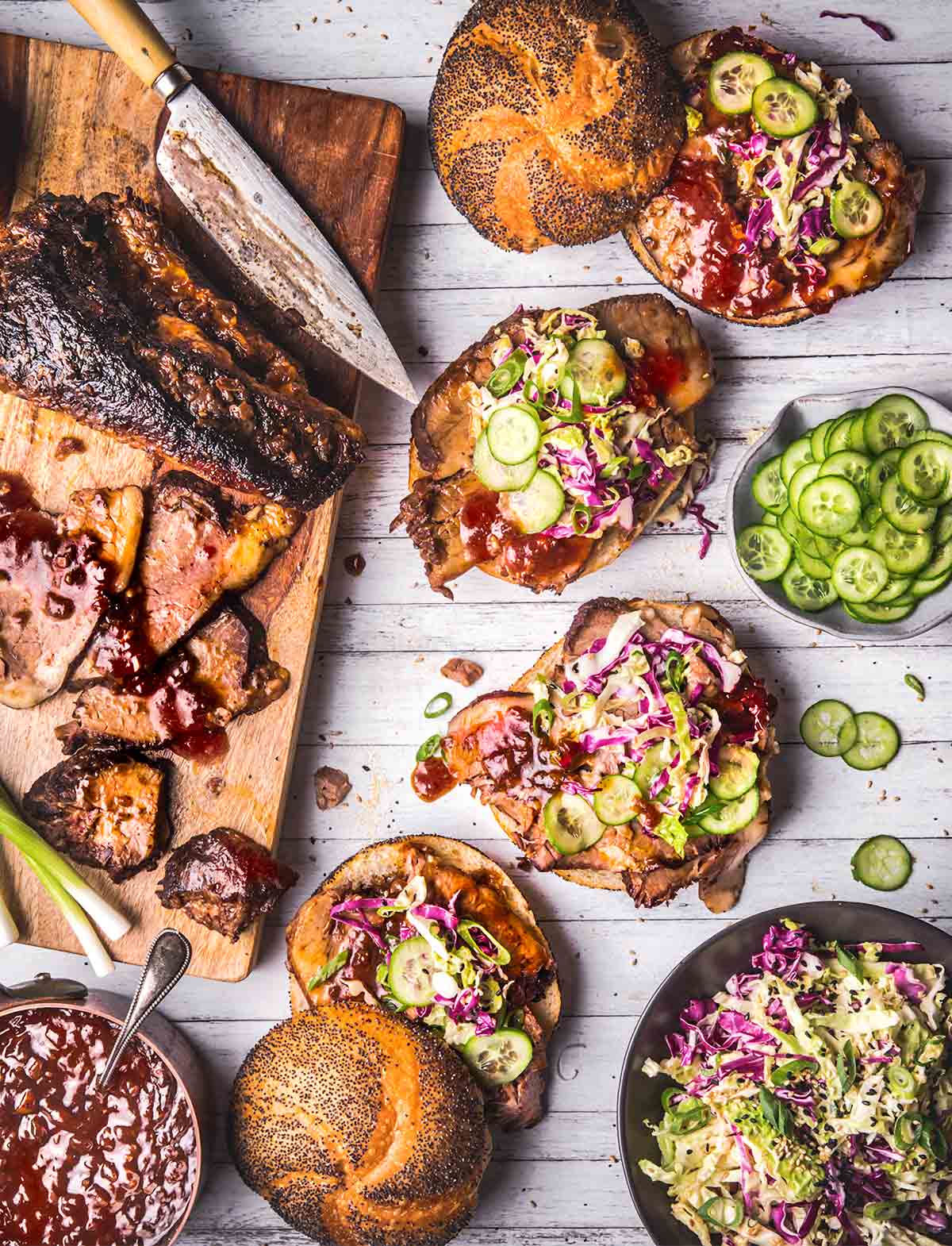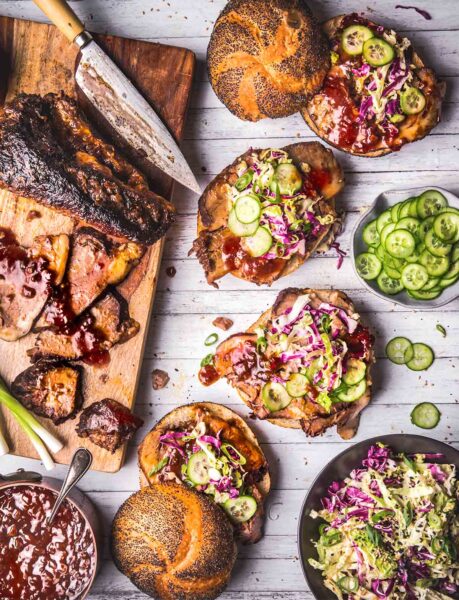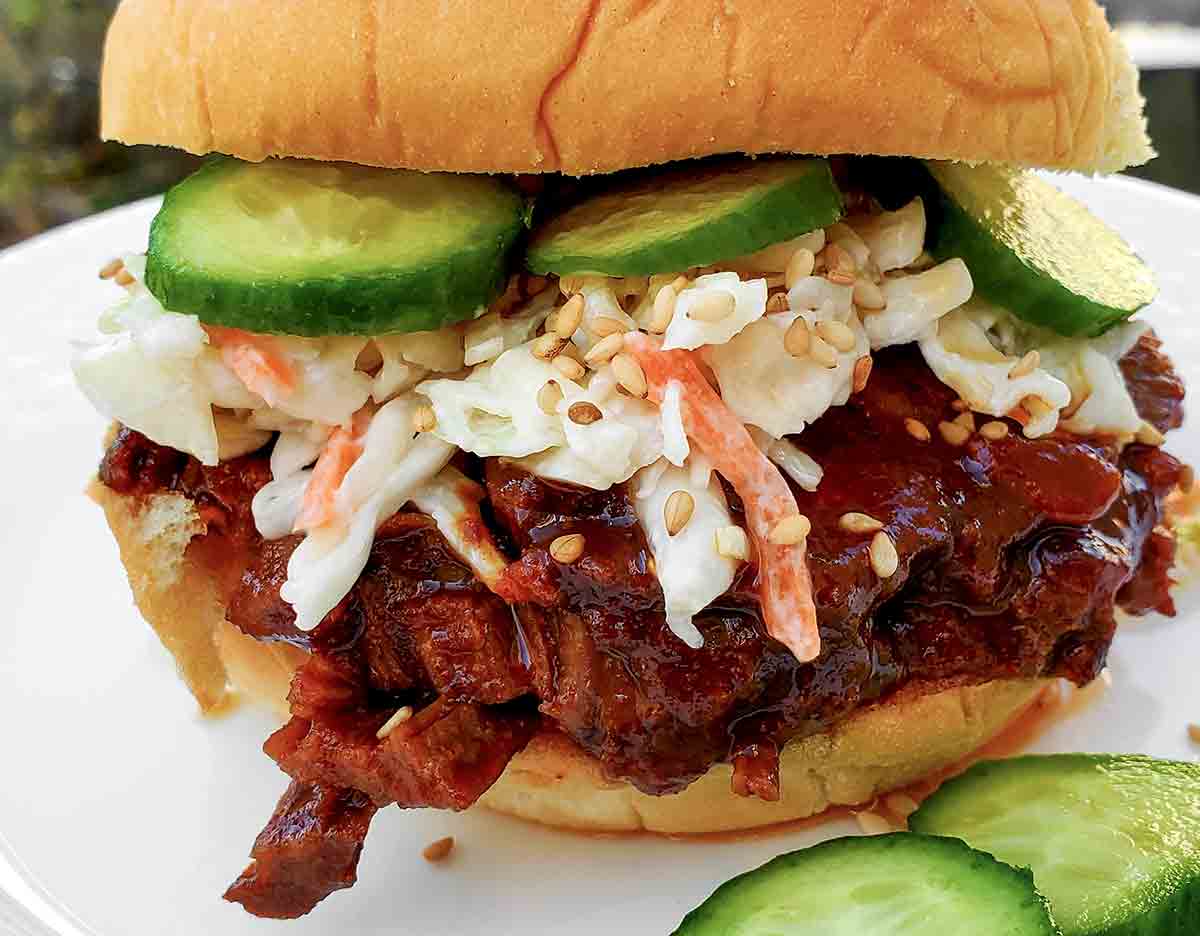
Emily’s two culinary influences are Jewish and Korean, and this recipe combines the two. Brisket, a staple of Jewish cuisine, is often braised with onions and tomatoes. We like to switch things up and use gochujang (spicy Korean chili paste), along with gochugaru (the chili powder used to make kimchi). They both have a rich, spicy flavor, transforming the braising liquid into a really excellent barbeque sauce. We like to serve it in toasted potato buns topped with a heap of crunchy homemade coleslaw.—Emily & Matt Clifton
Want to Save This?
Korean-Inspired Brisket Sandwiches FAQs
The second cut, or deckle, is fattier and thus has more flavor (the first cut is lean and may dry out during cooking.) Trim any large, thick pieces of fat, but leave a fat cap, which will baste the meat as it braises.
The fabulous Korean chili powder is finally getting some love over here but if you can’t find any yet, you can always substitute 1 tablespoon of hot paprika plus 1 tablespoon of mild paprika.

Korean-Inspired Brisket Sandwiches with Sesame Coleslaw
Ingredients
For the brisket
- 4 to 5 pounds brisket (look for second cut, also called deckle), lightly trimmed of excess fat
- 1 1/2 tablespoons kosher salt, plus more if needed
- 1 tablespoon garlic powder
- 1 tablespoon onion powder
- 2 tablespoons gochugaru (Korean red chile powder)
For the sauce
- 2 tablespoons mild vegetable oil, plus more as needed
- 1 large (11oz) Spanish onion, finely chopped
- 7 large cloves garlic, minced or grated
- 2 tablespoons grated fresh ginger
- 1 cup dry red wine
- 3 cups store-bought or homemade chicken stock, plus more if needed
- 1/4 cup store-bought or homemade gochujang (spicy Korean chili paste)
- 1/2 cup ketchup
- 2 tablespoons soy sauce
- 3 tablespoons brown sugar
- 1 tablespoon Worcestershire sauce
- 1 tablespoon fish sauce
- 1 tablespoon cornstarch (optional)
For the coleslaw
- 3 cups finely shredded napa cabbage
- 2 cups finely shredded red cabbage
- 1 teaspoon kosher salt
- 1 tablespoon toasted sesame oil
- 2 tablespoons unseasoned rice vinegar
- 1/4 cup mayonnaise (preferably Japanese-style)
- 3 scallions, finely sliced
- 2 tablespoons toasted sesame seeds, (preferably a mix of black and white)
For serving
- Potato buns or sandwich rolls
- 3 small Persian cucumbers, thinly sliced (optional)
Instructions
Make the brisket
- If needed, cut the brisket into two or more pieces that will fit into your Dutch oven.
- In a small bowl, mix together the salt, garlic powder, onion powder, and gochugaru. Place the brisket on a large plate and sprinkle the rub generously all over the meat, and press it in. You may not need all of it depending on the size of the brisket.
- Leave the brisket at room temperature for 1 hour or cover it with plastic wrap and refrigerate for up to 24 hours.
- Preheat the oven to 275°F (135°C) and place a rack in the lower middle slot.
Make the sauce
- Heat the oil in a large Dutch oven over medium-high heat. Add the onion, garlic, and ginger and cook, stirring occasionally, until the onion turns soft and golden, 5 to 7 minutes.
- Stir in the wine, stock, gochujang, ketchup, soy sauce, brown sugar, Worcestershire sauce, and fish sauce. Add the brisket to the Dutch oven. The liquid should be somewhere between one-half to three-quarters of the way up the meat. Add more stock or water, if needed. Bring the liquid to a boil.
- Cover the Dutch oven and slide it into the oven. Cook, checking every hour and spooning braising liquid over the top, until the brisket is very tender, about 3 1/2 hours. Remove the lid for the last hour of cooking.
- Transfer the beef to a plate or a rimmed cutting board and tent it with foil to keep it warm.
- Place the Dutch oven over medium-low heat and simmer the sauce until it is reduced to about 3 cups (it will thicken more as it cools), about 20 minutes. If you like a thicker sauce, stir in a cornstarch slurry. In a small bowl, stir together the cornstarch with 2 tablespoons (30 ml) of cold water. While the sauce is simmering, stir in half of the slurry. If the sauce still needs thickening, add the other half of the slurry.
- We like to make the brisket a full day (or up to 3 days) ahead. Place the unsliced brisket back in the Dutch oven and refrigerate overnight. Once it’s cold, it’s very easy to pull the solid fat off the top of the sauce. If you like thin, neat slices of brisket, take it out of the sauce and slice it, against the grain, while it’s cold. To reheat it, place the slices back in the pot with sauce, bring it to a simmer over low and heat until it’s warmed through. You can also reheat the sliced brisket in the Dutch oven in a 275°F (135°C) oven until hot, about 15 minutes.
- If you’re serving it the same day, let the brisket rest for at least 20 minutes before slicing. Make sure to use a sharp knife and cut against the grain. (If you look at the brisket, you’ll see the muscle fibers running in one direction. Cutting across these fibers shortens them, which makes for a tender piece of meat. If you slice with the grain, the brisket will be stringy and difficult to chew, no matter how you’ve cooked it.) Use a fat separator or a spoon to skim the fat off the sauce.
Make the coleslaw
- In a large bowl, combine the cabbages and toss them with salt.
- In a small bowl, mix together the sesame oil, rice vinegar, and mayonnaise. Add the dressing to the cabbage along with the scallions and sesame seeds and toss to combine.
- To serve, pile some brisket onto a bun, drizzle over some of the sauce and top it with coleslaw and some cucumbers, if desired. Have plenty of napkins handy.

Explore More with AI
Nutrition
Nutrition information is automatically calculated, so should only be used as an approximation.
Recipe Testers’ Reviews
These Korean-inspired brisket sandwiches with sesame coleslaw are a spicy and delicious meal that takes very little effort for the results! I love spicy and this recipe packed a decent punch. It could easily be dialed down if you prefer a more mild sandwich.

The brisket was cooked to perfection and the accompanying sauce and slaw were terrific. Absolutely loved the touch of sesame oil and the seeds. The cucumbers added a needed and delightful cool crunch. Purple/red cabbage was not available, so I used some grated carrots for color. If you don’t want to add wine, simply substitute apple cider. I used a brisket that was under two pounds and it easily could have made four-six sandwiches on potato buns.
I’ve never made brisket before, and this “spicy” Korean-inspired version is not the one-note smoked brisket we get at our local shop. It isn’t very spicy, but that’s appealing in a family of people with varying spice tolerance. The gochugaru and gochujang, ingredients we use often, provide layers of flavor rather than heat in this recipe. The large amount of sauce kept even our first-cut brisket from being dry.
The slaw is very good, but could use a pinch more acid, and that part of the recipe doesn’t make nearly enough to match the amount of beef—be prepared to make more as there are plenty of leftovers. Instead of plain cucumbers, I pickled four of them quickly with a small sliced red onion (1/4 c. rice vinegar, 1 tablespoon sugar, 1 teaspoon Maldon) and in an hour they were ready to top the slaw, providing more tang and even more color.













Greetings! Question on coleslaw. The last ingredient you mention either black or white but what? This for the brisket.
Pedro, greetings right back! It’s supposed to be toasted sesame seeds. For some reason it was hiding behind the link to purchase. But it’s all set now.
This was absolutely delicious! My family loved it. I did add a little additional brown sugar to the sauce. We had it for a holiday dinner just as brisket and then made sandwiches with the delicious coleslaw on brioche rolls for dinner a few days later. This recipe is a “keeper”!
Thanks, Dawn! We’re so pleased that you love it. Thanks for taking the time to comment and rate the recipe.
I’ve made this recipe several times and everyone loves it. Last week, my husband made the slaw portion to serve with Korean-style tacos. It was perfect!
Fantastic, Angelene! We are thrilled this is such a hit with your family!